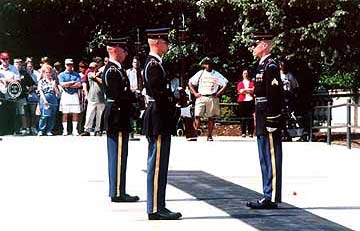Memorials
Rolling Thunder at Arlington
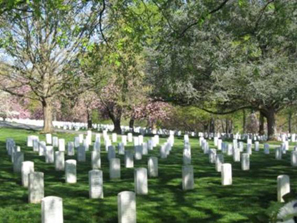
No other nation goes to the effort the United States does to recover and pay tribute to its war dead, a military tradition older than the ancient Athens. There, in 431 B.C., selected warriors were returned from the Peloponnesian battlefield with great ceremony, each tribe represented by a dead fighter borne home in a cypress coffin, with one empty bier representing all of the missing, “that is, for those whose bodies could not be recovered,” wrote Thucydides. “The bones are laid in the public burial place, which is in the most beautiful quarter outside the city walls. Here the Athenians always bury those who have fallen in war.”
The historian might have been describing Arlington. Since the time of Thucydides, societies have developed countless ways of honoring their war dead—by building monuments to those they could not recover, by elevating one unknown warrior to stand for all who sacrificed, by designating holidays for decorating graves with flowers, by establishing national cemeteries on foreign soil to recognize those who died far from home.
Thousands who sleep at Arlington today were brought there by the Civil War, a national trauma so unexpected and so extensive that, five years after Appomattox, recovery teams were still combing old battlefields around Washington to find, identify, and reinter thousands of casualties from both sides. Learning from the mistakes of that war, the United States created a national cemetery system, with Arlington at its heart, and slowly developed expertise in treating its war dead with exquisite care. That tradition continues, as the United States dispatches specialty teams around the world to recover its dead from active theaters of conflict, as well as those from earlier wars.
It was such an effort that finally brought the members of Breaker Patrol, 3rd Reconnaissance Battalion, 3rd Marine Division, to Arlington for a long-delayed homecoming on May 10, 2005—exactly thirty-eight years after they disappeared in Vietnam: They were Navy Petty Officer 3rd Class Malcolm T. Miller, Marine 2nd Lt. Heinz Ahlmeyer Jr., Marine Sgt. James N. Tycz, and Marine Lance Cpl. Samuel A. Sharp Jr. All had died in a fierce fight for the high ground near Khe Sanh on May 10, 1967. While their wounded comrades were evacuated by helicopter, it was too late for Miller, Ahlmeyer, Tycz, and Sharp—left behind but not forgotten. Years after the war ended, forensic teams returned to the battlefield in 2002 and 2003 and recovered thirty-one bone fragments, some teeth, and enough supporting evidence to make positive identifications of the four men. Corporal Sharp was the first to reach home, where he was buried in his native California a few days before the Arlington ceremony. He would be remembered at Arlington, where four caskets stood ready for burial in Section 60—one for Miller, one for Ahlmeyer, one for Tycz, and one for unidentifiable remains representing all of the dead from Breaker Patrol.
The fourth casket containing commingled bones was on its way down to Section 60 from the chapel at Fort Myer. You could gauge its progress by the rattle of drums drawing closer, setting the pace for a slow parade of two hundred mourners, a Marine rifle platoon in dress blues and white trousers, a Marine band in gold braid and scarlet, and bringing up the rear, a squadron of Rolling Thunder—Vietnam veterans on Harleys. This mismatched procession streamed down the hills in brilliant sunlight, turned left on Marshall Drive, and came to a halt on Bradley Drive, where the earth was laid open to make four new graves.
Six burly marines from the burial detail drew the fourth casket from a silver hearse, marched it across the grass, and stopped by the last grave. The Marine Band struck up the Navy Hymn. The body bearers hoisted the last casket shoulder high until the song was done, then eased it onto a catafalque, lifted away its flag, pulled the edges tight, and held it there as a Navy chaplain began to murmur the familiar words of comfort, but these were snatched away by the sounds of life intruding from all around the cemetery, in the drone of commuter traffic just outside the stone walls, in the whine of jets straining up from Reagan National Airport, in the thump of helicopters lumbering to and from the Pentagon. No matter how solemn the rituals at Arlington, life continued asserting itself from outside. And even in the cemetery, the living formed a link with all of the dead who had gone before—by speaking their names, by recounting their acts of duty and valor, by suspending the other imperatives of life for a few minutes of ritual and reflection. These acts convey a sort of immortality upon the dead, who continue to live as long as they are remembered.
Out among the tombstones, the long journey of Breaker Patrol was drawing to its conclusion. A firing party unleashed a three-rifle volley, a lone bugler stepped forward to sound Taps, and the honor guard began folding the last flag, pulling the fabric taut, creasing it, gathering it, and passing it down the line until it formed a tight blue triangle. With a sharp salute, the flag passed to a gunnery sergeant, who cradled it like a baby, marched it across the turf, and presented it to chaplain. The chaplain, in turn, passed it to a retired Marine commandant acting as next of kin for all of those in Breaker Patrol.
Last of all, the motorcycle vets padded onto the grass and knelt, one by one, at each of the caskets to retire their MIA bracelets. Dressed in faded jeans and camouflage, the bikers looked incongruous among the spit-and-polish crowd that day, but when they stepped up to a grave, stood straight, and snapped off a salute, you could see that they had been soldiers too, and some of them were crying.
An excerpt from the book:
On Hallowed Ground
The story of Arlington National Cemetery
By Robert M. Poole
Reprinted by permission of Walker & Co
Tomb Guard Sentinels
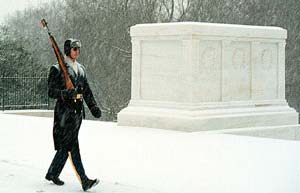 The Tomb of the Unknowns (also known as the Tomb of the Unknown Soldier) is guarded 24 hours a day, 365 days a year, and in any weather by Tomb Guard sentinels. Sentinels, all volunteers, are considered to be the best of the elite 3rd U.S. Infantry (The Old Guard), headquartered at Fort Myer, VA.
The Tomb of the Unknowns (also known as the Tomb of the Unknown Soldier) is guarded 24 hours a day, 365 days a year, and in any weather by Tomb Guard sentinels. Sentinels, all volunteers, are considered to be the best of the elite 3rd U.S. Infantry (The Old Guard), headquartered at Fort Myer, VA.
The Sentinels of the Tomb of the Unknown Soldiers march 24 hours a day, 7 days a week, in any weather.
After members of the 3rd U.S. Infantry become ceremonially qualified, they are eligible to volunteer for duty as sentinels at the Tomb. If accepted, they are assigned to Company E of The Old Guard. Each soldier must be in superb physical condition, possess an unblemished military record and be between 5 feet, 10 inches and 6 feet, 4 inches tall, with a proportionate weight and build. An interview and a two-week trial to determine a volunteer’s capability to train as a tomb guard is required.
During the trial phase, would-be sentinels memorize seven pages of Arlington National Cemetery history. This information must be recited verbatim in order to earn a “walk.” A walk occurs between guard changes. A daytime walk is one-half hour in the summer and one hour in the winter. All night walks are one hour.
If a soldier passes the first training phase, “new-soldier” training begins. New sentinels learn the history of Arlington National Cemetery and the grave locations of nearly 300 veterans. They learn the guard-change ceremony and the manual of arms that takes place during the inspection portion of the Changing of the Guard. Sentinels learn to keep their uniforms and weapons in immaculate condition.
The sentinels will be tested to earn the privilege of wearing the silver Tomb Guard Identification Badge after several months of serving. First, they are tested on their manual of arms, uniform preparation and their walks. Then, the Badge Test is given. The test is 100 randomly selected questions of the 300 items memorized during training on the history of Arlington National Cemetery and the Tomb of the Unknowns. The would-be badge holder must get more than 95 percent correct to succeed. Since the first Tomb Guard Badge was awarded in February 1958, 46 years ago, some 525 have been awarded.
The Tomb Guard Identification Badge is a temporary award until the badge-holding sentinel has honorably served at the Tomb of the Unknowns for nine months. At that time, the award can be made a permanent badge, which may then be worn for the rest of a military career. The silver badge is an upside-down, laurel-leaf wreath surrounding a depiction of the front face of the Tomb. Peace, Victory and Valor are portrayed as Greek figures. The words “Honor Guard” are shown below the Tomb on the badge.
There are three reliefs, each having one relief commander and about six sentinels. The three reliefs are divided by height so that those in each guard change ceremony look similar. The sentinels rotate walks every hour in the winter and at night, and every half-hour in the day during the summer.
The Tomb Guard Quarters is staffed using a rotating Kelly system. Each relief has the following schedule: first day on, one day off, second day on, one day off, third day on, four days off. Then, their schedule repeats.
The Changing of the Guard
The guard is changed every hour on the hour Oct. 1 to March 31 in an elaborate ritual. From April 1 through September 30, there are more than double the opportunities to view the change because another change is added on the half hour and the cemetery closing time moves from 5 to 7 p.m.
An impeccably uniformed relief commander appears on the plaza to announce the Changing of the Guard. Soon the new sentinel leaves the Quarters and unlocks the bolt of his or her M-14 rifle to signal to the relief commander to start the ceremony.
The relief commander walks out to the Tomb and salutes, then faces the spectators and asks them to stand and stay silent during the ceremony.
The relief commander conducts a detailed white-glove inspection of the weapon, checking each part of the rifle once. Then, the relief commander and the relieving sentinel meet the retiring sentinel at the center of the matted path in front of the Tomb. All three salute the Unknowns who have been symbolically given the Medal of Honor. Then the relief commander orders the relieved sentinel, “Pass on your orders.” The current sentinel commands, “Post and orders, remain as directed.” The newly posted sentinel replies, “Orders acknowledged,” and steps into position on the black mat. When the relief commander passes by, the new sentinel begins walking at a cadence of 90 steps per minute.
The Tomb Guard marches 21 steps down the black mat behind the Tomb, turns, faces east for 21 seconds, turns and faces north for 21 seconds, then takes 21 steps down the mat and repeats the process. After the turn, the sentinel executes a sharp “shoulder-arms” movement to place the weapon on the shoulder closest to the visitors to signify that the sentinel stands between the Tomb and any possible threat. Twenty-one was chosen because it symbolizes the highest military honor that can be bestowed — the 21-gun salute.
Duty time when not “walking” is spent in the Tomb Guard Quarters below the Memorial Display Room of the Memorial Amphitheater where they study Cemetery “knowledge,” clean their weapons and help the rest of their relief prepare for the Changing of the Guard. The guards also train on their days off.
The Guards of Honor at the Tomb of the Unknowns are highly motivated and are proud to honor all American service members who are “Known But to God.”
Source-Courtesy of the U.S. Army Military District of Washington
To learn about Memorial Day Services in our Capital go to: www.mdw.army.mil
Tomb of the Unkown Soldier
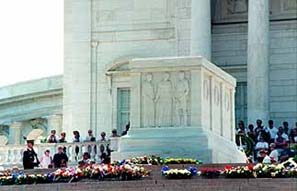
The Tomb of the Unknowns at Arlington National Cemetery in Arlington, Va., is also known as the Tomb of the Unknown Soldier, and has never been officially named. The Tomb of the Unknowns stands atop a hill overlooking Washington, D.C.
On March 4, 1921, Congress approved the burial of an unidentified American soldier from World War I in the plaza of the new Memorial Amphitheater.
The white marble sarcophagus has a flat-faced form and is relieved at the corners and along the sides by neo-classic pilasters, or columns, set into the surface. Sculpted into the east panel which faces Washington, D.C., are three Greek figures representing Peace, Victory, and Valor. Inscribed on the back of the Tomb are the words:
HERE RESTS IN HONORED GLORY AN AMERICAN SOLDIER KNOWN BUT TO GOD
The Tomb sarcophagus was placed above the grave of the Unknown Soldier of World War I. West of the World War I Unknown are the crypts of unknowns from World War II, Korea and Vietnam. Those three graves are marked with white marble slabs flush with the plaza.
THE UNKNOWN OF WORLD WAR I
On Memorial Day, 1921, four unknowns were exhumed from four World War I American cemeteries in France. U.S. Army Sgt. Edward F. Younger, who was wounded in combat, highly decorated for valor and received the Distinguished Service Medal in “The Great War, the war to end all wars,” selected the Unknown Soldier of World War I from four identical caskets at the city hall in Chalons-sur-Marne, France, Oct. 24, 1921.
Sgt. Younger selected the unknown by placing a spray of white roses on one of the caskets. He chose the third casket from the left. The chosen unknown soldier was transported to the United States aboard the USS Olympia. Those remaining were interred in the Meuse Argonne Cemetery, France.
The Unknown Soldier lay in state in the Capitol Rotunda from his arrival in the United States until Armistice Day, 1921. On Nov. 11, 1921, President Warren G. Harding officiated at the interment ceremonies at the Memorial Amphitheater at Arlington National Cemetery.
THE UNKNOWNS OF WORLD WAR II AND KOREA
On Aug. 3, 1956, President Dwight D. Eisenhower signed a bill to select and pay tribute to the unknowns of World War II and Korea. The selection ceremonies and the interment of these unknowns took place in 1958. The World War II Unknown was selected from remains exhumed from cemeteries in Europe, Africa, Hawaii and the Philippines.
Two unknowns from World War II, one from the European Theater and one from the Pacific Theater, were placed in identical caskets and taken aboard the USS Canberra, a guided-missile cruiser resting off the Virginia capes. Navy Hospitalman 1st Class William R. Charette, then the Navy’s only active-duty Medal of Honor recipient, selected the Unknown Soldier of World War II. The remaining casket received a solemn burial at sea.
Four unknown Americans who died in the Korean War were disinterred from the National Cemetery of the Pacific in Hawaii. Army Master Sgt. Ned Lyle made the final selection. Both caskets arrived in Washington May 28, 1958, where they lay in the Capitol Rotunda until May 30.
That morning, they were carried on caissons to Arlington National Cemetery. President Eisenhower awarded each the Medal of Honor, and the Unknowns were interred in the plaza beside their World War I comrade.
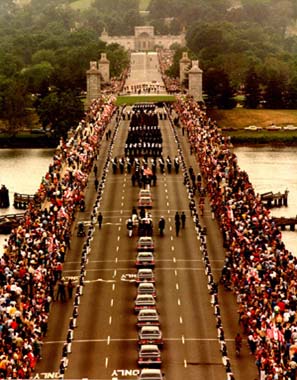
The Unknown of Vietnam
The Unknown service member from the Vietnam War was designated by Medal of Honor recipient U.S. Marine Corps Sgt. Maj. Allan Jay Kellogg Jr. during a ceremony at Pearl Harbor, Hawaii, May 17, 1984.
The Vietnam Unknown was transported aboard the USS Brewton to Alameda Naval Base, Calif. The remains were sent to Travis Air Force Base, Calif., May 24. The Vietnam Unknown arrived at Andrews Air Force Base, Md., the next day.
Many Vietnam veterans and President and Mrs. Ronald Reagan visited the Vietnam Unknown in the U.S. Capitol. An Army caisson carried the Vietnam Unknown from the Capitol to the Memorial Amphitheater at Arlington National Cemetery on Memorial Day, May 28, 1984.
President Reagan presided over the funeral, and presented the Medal of Honor to the Vietnam Unknown.
The president also acted as next of kin by accepting the interment flag at the end of the ceremony. The interment flags of all Unknowns at the Tomb of the Unknowns are on view in the Memorial Display Room.
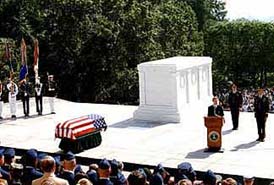
Source-Courtesy of the U.S. Army Military District of Washington
To learn about Memorial Day Services in our Capital go to: www.mdw.army.mil

